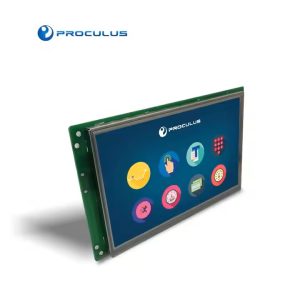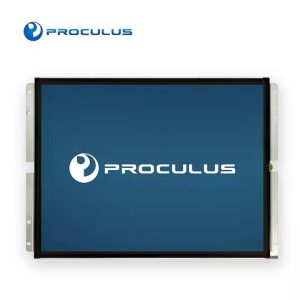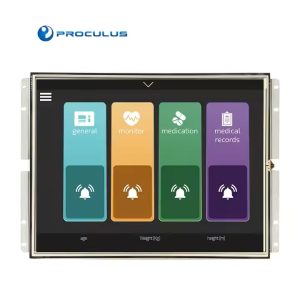Screen display resolutions: Definitions and uses guide
Understanding screen display resolutions is essential when designing or selecting a display for any modern digital interface, whether for embedded systems, industrial HMIs, or high-performance applications.
A screen’s resolution not only determines how much information can be visually represented, but also impacts user experience, interface design, processing requirements, and energy consumption.
For engineers and developers working with graphical interfaces, choosing the appropriate resolution means finding the right balance between visual clarity, hardware capabilities, and system efficiency.
This guide explores the key concepts behind screen resolutions, their practical implications, and how to select the best option for your specific project needs. Keep reading!
What is screen display resolution?
Screen resolution defines the amount of visual detail a display can present.
It is typically expressed in terms of pixel dimensions (such as 800×480 or 1920×1080), representing the number of horizontal and vertical pixels, respectively.
This measurement directly influences how sharp and clear images, text, and graphical elements appear on the screen.
In practical terms, resolution affects everything from how much information can fit on a display to how user interfaces are scaled and rendered.
Higher resolution allows for more detailed visuals and smoother graphics, while lower resolutions may result in a more pixelated appearance, but can reduce processing demands and power consumption, factors that are often crucial in embedded systems.
When designing an interface or selecting a display for an HMI or industrial application, the ideal resolution balances performance, cost, power efficiency, and visual clarity.
What are Pixels?
Pixels (short for “picture elements”) are the smallest controllable components of a digital display.
Each pixel can emit a specific color and brightness, and when combined across the entire display, they form the images and text you see on the screen.
Displays are essentially a grid of these pixels.
The density and arrangement of these pixels determine the screen’s ability to render fine detail.
In modern displays, each pixel typically comprises sub-pixels in red, green, and blue (RGB).
These sub-pixels vary in intensity to produce a full spectrum of colors.
The quality of a screen’s image is heavily influenced not just by the number of pixels, but also by factors such as pixel density (measured in PPI – pixels per inch), pixel layout, and display technology.
Why does resolution matter for image quality?
Screen resolution plays a direct role in defining the clarity, sharpness, and overall fidelity of a digital display.
Higher resolutions mean more pixels are packed into the same physical space, allowing for more detailed and lifelike images.
This is particularly important in environments where visual precision is critical, such as medical diagnostics, industrial monitoring systems, and advanced HMIs (Human-Machine Interfaces).
In practical terms, a higher resolution allows UI elements, like icons, buttons, and data visualizations, to appear more refined and readable, without visible pixelation.
Text becomes crisper, graphics smoother, and gradients more natural.
Conversely, using a low-resolution display where a higher one is required can lead to blurred visuals, distorted proportions, and user fatigue from interpreting less legible information.
Moreover, when designing a graphical interface, the resolution determines how much visual real estate is available.
This affects layout decisions, the complexity of information that can be displayed at once, and how interactive elements are spaced, all of which contribute to overall user experience and usability.
What does “1080p” mean?
The term “1080p” refers to a screen resolution of 1920 pixels wide by 1080 pixels tall, arranged in a progressive scan format.
In contrast to interlaced scanning (used in older display technologies), progressive scan means each frame is drawn line by line from top to bottom, resulting in smoother motion and better image stability, especially in dynamic or fast-refresh applications.
How does screen size affect resolution?
Screen size and resolution are interdependent factors that together determine pixel density, typically measured in pixels per inch (PPI).
While resolution defines how many pixels a screen can display, screen size dictates how physically spread out those pixels are.
For example, a 7-inch display at 800×480 resolution will have a much higher pixel density, and therefore sharper visuals, than a 15-inch display at the same resolution.
On larger displays, the same number of pixels must cover a greater area, which can lead to visible pixelation and reduced clarity if resolution isn’t sufficiently high.
What are the most popular resolutions for computer monitors today?
In today’s technology landscape, monitor resolutions vary widely depending on the use case, from industrial displays to office workstations and high-end professional environments.
Below are the most commonly used resolutions:
- 1920×1080 (Full HD or 1080p): This is the industry standard for most general-purpose monitors, offering a good balance between performance and image clarity. It’s widely used in consumer electronics, industrial control interfaces, and embedded GUIs.
- 2560×1440 (QHD or 2K): Popular among engineers, developers, and creative professionals. It provides 77% more screen space than Full HD, allowing for detailed visualizations and multiple windows on screen without crowding.
- 3840×2160 (4K UHD): It is favored in high-end applications such as video editing, CAD design, and scientific visualization. It provides exceptional detail but requires powerful graphics processing and is less common in embedded systems due to hardware demands.
- 1280×800 / 1024×600 / 800×480: These are common resolutions in embedded systems, handheld terminals, and industrial equipment. Their aspect ratios and pixel densities are optimized for compact layouts and efficient rendering on lower-power hardware.
- 1366×768 (HD): Still used in budget devices and legacy industrial systems. Though lower in pixel count, it can be effective in non-graphically intensive use cases.
What are the different types of monitor resolutions?

Monitor resolutions vary widely depending on the application, that is, whether in consumer electronics, industrial automation, medical devices, or embedded systems.
Understanding the common categories helps in selecting the right display for your project’s performance and size constraints:
QVGA (320×240)
One of the earliest color LCD resolutions, QVGA is still used in legacy systems and ultra-compact devices where basic UI elements and minimal graphical requirements suffice.
WQVGA (480×272)
Popular in cost-sensitive embedded applications, this resolution offers a balance between display clarity and resource efficiency. It’s often found in handheld devices, simple control panels, and IoT interfaces.
WVGA (800×480)
A standard for mid-size HMI applications, this resolution provides enough screen real estate for touch interfaces, control elements, and basic graphics. Ideal for industrial and automotive UIs.
SVGA/XGA (800×600, 1024×768)
These formats are found in slightly older desktop monitors and some legacy industrial equipment. XGA, in particular, provides more vertical space, which can benefit form-based UIs.
WXGA (1280×800)
A versatile resolution found in tablets, POS systems, and mid-range display modules. It delivers decent clarity for complex interfaces while remaining power-efficient.
HD and FHD (1280×720, 1920×1080)
These higher resolutions are essential for media-rich applications or where visual detail is critical. FHD is common in diagnostic tools, video monitoring systems, and advanced HMI terminals.
QHD, 4K UHD and beyond (2560×1440, 3840×2160+)
High-resolution formats suitable for professional-grade applications such as precision visualization, medical imaging, and high-end equipment interfaces.
Discover Smart Displays for Every Project with Proculus Technologies
Whether you’re developing a compact, low-power control panel or a high-resolution, Android-powered touch interface, Proculus Technologies offers a complete portfolio of intelligent display solutions tailored to your project’s needs.
Our UART LCD modules simplify communication with microcontrollers, drastically reducing development time thanks to our powerful UnicView Studio software.
For applications demanding more flexibility, our Android-based displays provide a rich platform with expanded capabilities such as Wi-Fi, Bluetooth, and advanced UI rendering.
We support resolutions ranging from 480×272 to 1920×1080 and beyond, with options including:
- TFT LCD modules with UART interface
- High-resolution Android LCDs
- HDMI-compatible modules for plug-and-play development
- P.BOX development kits for rapid prototyping
- Customization services for specialized applications
Each product is backed by our commitment to quality, developer support, and long-term availability—ensuring you have the tools you need from prototype to production.
Explore our full range of Proculus display modules to find a solution that meets your technical and operational requirements.
Whether you’re an embedded engineer, system integrator, or OEM, our displays are built to accelerate your development and ensure dependable performance in real-world environments.
Conclusion
Choosing the right monitor resolution is more than a technical specification—it directly affects usability, performance, and the perceived quality of your product.
At Proculus Technologies, we understand these needs and provide display solutions engineered for reliability, scalability, and visual excellence.
With our modular products, intuitive development tools, and expert support, you’re equipped to build better, faster, and smarter.

 English
English


